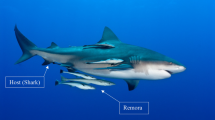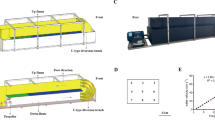Abstract
It has been known that small fish often swim in front of large fish, but the reason for this remains unclear. We hypothesized that small fish could swim more efficiently in front of large fish than when swimming singly. Computational fluid dynamical (CFD) analysis was conducted to verify this hypothesis. We calculated and compared the drag that affects small fish (bigeye trevally Caranx sexfasciatus) when swimming alone and that when tandem swimming in front of large fish (whale shark Rhincodon typus); the analysis was performed by changing the distance between the two fish. The results show that the drag coefficient of Caranx sexfasciatus when tandem swimming is smaller than the drag coefficient when swimming singly, and as the distance decreases, so does the drag coefficient. As the mechanism of this phenomenon, the stagnation point located in front of the large fish (Rhincodon typus) reduces the pressure difference between the small fish's (Caranx sexfasciatus) front and rear. The strength of the pressure drag depends on the pressure difference before and after the object. Therefore, we consider it to be the reason for the reduced drag on Caranx sexfasciatus. Moreover, the relationship between distance and drag reduction effect was the exact opposite of a previous study. This is most likely due to the fact that the Reynolds number, body-length ratio, and dimensions of analysis are different from previous studies. This paper suggests that Caranx sexfasciatus swims in front of Rhincodon typus to reduce their travel cost and insights for a more detailed understanding of tandem swimming.








Similar content being viewed by others
References
Blender Foundation (2021) Blender.org. Electronic version, updated 8 March 2021. https://www.blender.org/. Accessed 8 March 2021
Borazjani I, Sotiropoulos F, Tytell ED, Lauder GV (2012) Hydrodynamics of the bluegill sunfish C-start escape response: three-dimensional simulations and comparison with experimental data. J Exp Biol 215:671–684
Chang X, Zhang L, He X (2012) Numerical study of the thunniform mode of fish swimming with different Reynolds number and caudal fin shape. Comput Fluids 68:54–70
Chao L-M, Pan G, Zhang D, Yan G-X (2019) On the thrust generation and wake structures of two travelling-wavy foils. Ocean Eng 183:167–174
Farina SC, Summers AP (2015) Biomechanics: boxed up and ready to go. Nature 517:274–275
Fish FE, Hui CA (1991) Dolphin swimming—a review. Mamm Rev 21:181–195
Fish FE, Legac P, Williams TM, Wei T (2014) Measurement of hydrodynamic force generation by swimming dolphins using bubble DPIV. J Exp Biol 217:252–260
Khalid MSU, Akhtar I, Dong H (2016) Hydrodynamics of a tandem fish school with asynchronous undulation of individuals. J Fluids Struct 66:19–35
Li N, Liu H, Su Y (2017) Numerical study on the hydrodynamics of thunniform bio-inspired swimming under self-propulsion. PLoS One 12:e0174740
Macias MM, Souza IF, Brasil Junior ACP, Oliveira TF (2020) Three-dimensional viscous wake flow in fish swimming - A CFD study. Mech Res Commun 107:103547
Marras S, Killen SS, Lindström J, McKenzie DJ, Steffensen JF, Domenici P (2015) Fish swimming in schools save energy regardless of their spatial position. Behav Ecol Sociobiol 69:219–226
Menter F, Kuntz M, Langtry R (2003) Ten years of industrial experience with the SST turbulence model. Turbulence, Heat and Mass Transfer 4:625–632
Motta PJ, Maslanka M, Hueter RE, Davis RL, de la Oarra R, Mulvany SL, Habegger ML, Strother JA, Mara KR, Gardiner JM, Tyminski JP, Zeigler LD (2010) Feeding anatomy, filter-feeding rate, and diet of whale sharks Rhincodon typus during surface ram filter feeding off the Yucatan Peninsula, Mexico. Zoology 113:199–212
Nakabo T, Matida Y, Yamaoka K, Nishida S (2001) Fishes of the Kuroshio Current. Osaka Aquarium KAIYUKAN, Osaka
Ohtake T, Nakae Y, Motohashi T (2007) Nonlinearity of the aerodynamic characteristics of NACA0012 aerofoil at low Reynolds numbers. J Jpn Soc Aeronaut Space Sci 55:439–445
OpenCFD (2020a) OpenFOAM: user guide: k-omega Shear Stress Transport (SST). Electronic version, updated 1 July 2020. https://www.openfoam.com/documentation/guides/latest/doc/guide-turbulence-ras-k-omega-sst.html. Accessed 8 March 2021
OpenCFD (2020b) OpenFOAM: user guide: omegaWallFunction. Electronic version, updated 22 December 2020. https://www.openfoam.com/documentation/guides/latest/doc/guide-bcs-wall-turbulence-omegaWallFunction.html. Accessed 15 April 2021
OpenCFD (2021) OpenFOAM® - official home of The Open Source Computational Fluid Dynamics (CFD) Toolbox. Electronic version, updated 8 march 2021. https://www.openfoam.com/. Accessed 8 March 2021
Payne NL, Iosilevskii G, Barnett A, Fischer C, Graham RT, Gleiss AC, Watanabe YY (2016) Great hammerhead sharks swim on their side to reduce transport costs. Nat Commun 7:12289
Riedeberger D, Rist U (2012) Numerical simulation of laminar-turbulent transition on a dolphin using the γ-Reθ Model. In: Nagel WE, Kröner DB, Resch MM (eds) High performance computing in science and engineering '11. Springer, Berlin, pp 379–391
Sumikawa H, Fukue T, Miyoshi T (2018) CFD-based visualization of differences in macroscopic flow pattern around several types of caudal fins. The 7th International Symposium in Aero Aqua Bio-Mechanisms. The Society of Aero Aqua Bio-Mechanisms, Tokyo
Susan ML (2019) Caranx sexfasciatus summary page. Electronic version, updated 18 October 2019. https://www.fishbase.se/summary/Caranx-sexfasciatus.html. Accessed 1 March 2021
Takagi T, Tamura Y, Weihs D (2013) Hydrodynamics and energy-saving swimming techniques of Pacific bluefin tuna. J Theor Biol 336:158–172
Tanaka H, Li G, Uchida Y, Nakamura M, Ikeda T, Liu H (2019) Measurement of time-varying kinematics of a dolphin in burst accelerating swimming. PLoS ONE 14:e0210860
Van Wassenbergh S, van Manen K, Marcroft TA, Alfaro ME, Stamhuis EJ (2015) Boxfish swimming paradox resolved: forces by the flow of water around the body promote manoeuvrability. J R Soc Interface 12:20141146
Verma S, Novati G, Koumoutsakos P (2018) Efficient collective swimming by harnessing vortices through deep reinforcement learning. Proc Natl Acad Sci U S A 115:5849–5854
Weihs D (2004) The hydrodynamics of dolphin drafting. J Biol 3:8
Witt WC, Wen L, Lauder GV (2015) Hydrodynamics of C-start escape responses of fish as studied with simple physical models. Integr Comp Biol 55:728–739
Woodcock AH (1948) The swimming of dolphins. Nature 161:602
Zhang N, Zheng ZC (2009) Flow/pressure characteristics for flow over two tandem swimming fish. Comput Fluids 38:1059–1064
Acknowledgments
The authors extend a special thanks to Kiyonori Nishida, Takahiro Inoda, Yoshikazu Kitadani, and Itsuki Kiyatake (Osaka Aquarium Kaiyukan Co., Ltd) for their hospitality and valuable advice. This study did not use actual fish and conducted while observing the Guidelines for the use of fish in research published by the Ichthyological Society of Japan in 2003.
Author information
Authors and Affiliations
Corresponding author
Additional information
Publisher's Note
Springer Nature remains neutral with regard to jurisdictional claims in published maps and institutional affiliations.
Supplementary Information
Below is the link to the electronic supplementary material.
Supplementary file2 (MP4 5621 kb)
About this article
Cite this article
Sumikawa, H., Miyoshi, T. The pressure drag reduction effect of tandem swimming by Caranx sexfasciatus and Rhincodon typus. Ichthyol Res 69, 132–139 (2022). https://doi.org/10.1007/s10228-021-00822-5
Received:
Revised:
Accepted:
Published:
Issue Date:
DOI: https://doi.org/10.1007/s10228-021-00822-5




